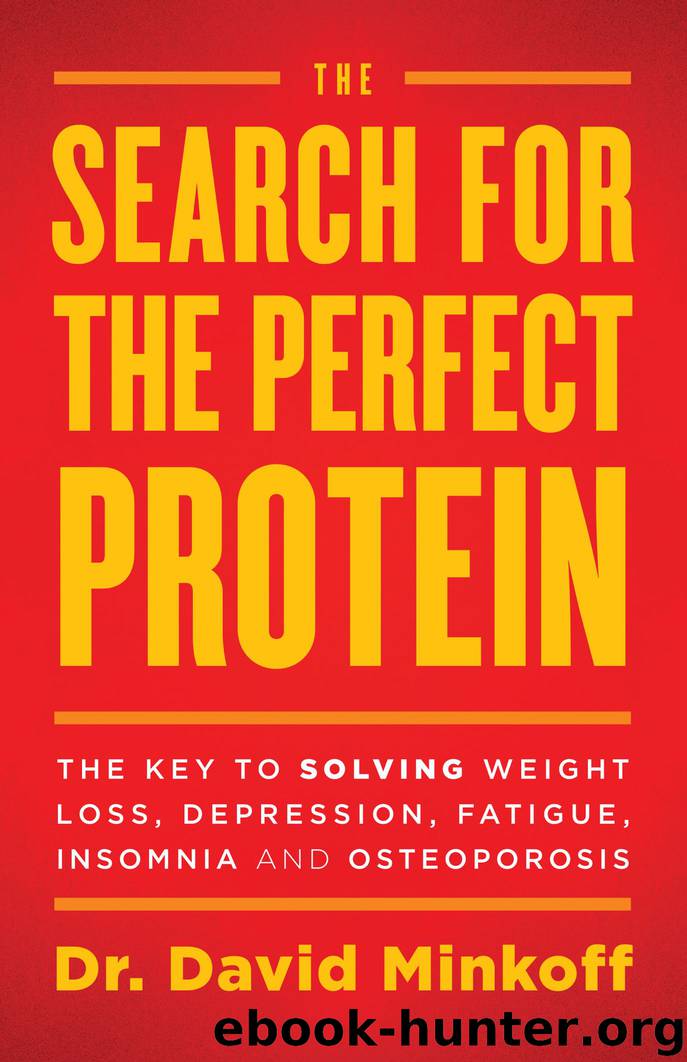The Search for the Perfect Protein by Dr. David Minkoff

Author:Dr. David Minkoff
Language: eng
Format: epub
Publisher: BookBaby
Published: 2019-05-04T17:33:28+00:00
The Small Intestinal Barrier and Leaky Gut
In most people, the small intestine is about twenty-five feet long, folded over itself numerous times. If you unfolded it, closed one end, and pumped air in, its surface area would be about the same as that of two tennis courts. Despite its huge area, it’s very compact, and every little fold has another fold; there are villi and microvilli to maximize the area and absorb nutrients, and there are enzymes on the surface to aid in digestion activation.
The inner lining of the small intestine is only one cell layer thick. In addition to the villi, there is a “glue” that holds these cells together. Let’s say someone eats a steak and it enters the body as the big, long chain of about 6100 amino acids per fiber. The pepsin in the stomach will cut them down to five hundred amino acid chains. When the partially digested proteins reach the small intestine, the pancreatic enzymes cut them down to single amino acids, or into short chains of a few amino acids. If the chains are longer than that, they will not be absorbed by the microvilli—they will be too big.
If the tight junctions between the small intestinal cells are too permeable due to local injury (see the chart for causes), the longer chains can pass through the tight junctions into the bloodstream—this is known as leaky gut. It’s “leaky” because substances that should never be allowed to enter the body do so through a “leak” in the intestinal wall barrier. The junction that was once tight is now open.
Our immune system considers most of these substances to be “foreign”—these are proteins that come from cows, pigs, bacteria, or parasites. As a safeguard, nature put three-fourths of our immune system within the wall of our small intestine as a shield against such invasions. This is known as the Gut Associated Lymphoid Tissue (GALT). When these foreign proteins pass through, an immune response is generated to target these invaders, and this process underlies most autoimmune diseases, like Rheumatoid Arthritis and Lupus. The immune system becomes so agitated from the load of foreign proteins that it begins to attack similar proteins in its own body, thus the autoimmune reaction. The system turns against its own tissue, and much like what happens in a war with friendly fire, an airplane drops a bomb on its own troops by mistake.
Download
This site does not store any files on its server. We only index and link to content provided by other sites. Please contact the content providers to delete copyright contents if any and email us, we'll remove relevant links or contents immediately.
How to Be a Bawse: A Guide to Conquering Life by Lilly Singh(7436)
Deep Work by Cal Newport(6966)
The Longevity Diet by Valter Longo(5040)
The Fat Loss Plan by Joe Wicks(4874)
The Four-Pack Revolution by Chael Sonnen & Ryan Parsons(3945)
The Ultimate Bodybuilding Cookbook by Kendall Lou Schmidt(3906)
The French Women Don't Get Fat Cookbook by Mireille Guiliano(3629)
Super Food Family Classics by Jamie Oliver(3383)
Not a Diet Book by James Smith(3374)
Factfulness_Ten Reasons We're Wrong About the World_and Why Things Are Better Than You Think by Hans Rosling(3216)
Turn Up Your Fat Burn! by Alyssa Shaffer(3195)
Self-Esteem by Matthew McKay & Patrick Fanning(3115)
Tom Kerridge's Dopamine Diet: My low-carb, stay-happy way to lose weight by Kerridge Tom(3078)
Body Love by Kelly LeVeque(3029)
The Unbecoming of Mara Dyer by Michelle Hodkin(3018)
The Fat Chance Cookbook by Robert H. Lustig(2811)
Tone Your Tummy Type by Denise Austin(2811)
LL Cool J's Platinum 360 Diet and Lifestyle by LL Cool J(2708)
Men's Health Best by Men's Health Magazine(2571)
